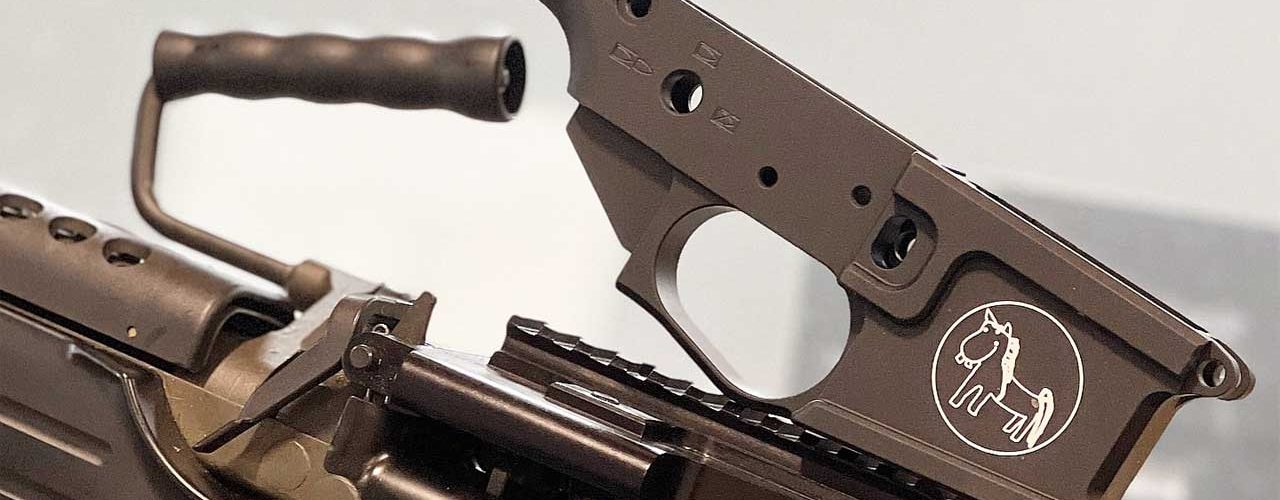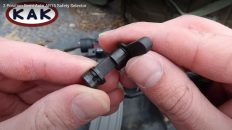In the world of firearms, there are many components that make up the whole. One of these components is the lower receiver, a crucial part that often sparks curiosity among enthusiasts. But what exactly is a lower receiver and what role does it play in the functioning of a firearm?
A lower receiver is essentially the framework of a firearm, acting as the central hub where various other AR-15 components are attached. It houses the trigger, magazine well, and stock, among other things, and connects the barrel and upper receiver to create a fully functional firearm.
Understanding the basics of a lower receiver is vital not only for gun enthusiasts who want to dive deeper into the mechanics of their firearms, but also for those new to the world of firearms who want to educate themselves on the different parts that make up these complex machines.
In this article, we will explore in detail what a lower receiver is, its purpose, and its importance in the world of firearms. So, let’s dive in and uncover the mysteries of this essential component.
The role of a lower receiver in a firearm
The lower receiver serves as the backbone of any firearm, particularly in modern rifles like the AR-15 platform. It is the component that houses several key AR-15 parts such as the trigger mechanism, magazine well, and buffer tube, making it integral to the rifle’s operation. The lower receiver connects the upper receiver, which contains the barrel and bolt carrier group, thereby facilitating the entire firing mechanism. Essentially, it acts as a bridge between various components, ensuring they work in harmony to deliver functionality.
Another critical role that the lower receiver plays is in the overall ergonomics and handling of the firearm. It is designed to accommodate the trigger and grip, allowing the shooter to operate the firearm comfortably and effectively. The design and configuration of the lower receiver directly impact how the firearm feels in hand and how easily one can aim and fire. This aspect is crucial for both novice shooters and seasoned marksmen, as comfort can significantly affect accuracy and performance.
Furthermore, the lower receiver is often where the firearm’s serial number is located, making it the legally defined part of the gun. This legal designation means that when purchasing or transferring firearms, the lower receiver is typically the component that requires background checks and registration. Understanding its role not only enhances one’s knowledge of firearms but also highlights the importance of the lower receiver in legal contexts.
Different types of lower receivers
When it comes to lower receivers, there are primarily two types: stripped and complete. A stripped lower receiver is essentially a blank slate, lacking any internal components such as the trigger group or buffer tube. This type is ideal for those who want to build their firearm from the ground up, allowing for customization based on personal preferences. Enthusiasts often choose stripped receivers to create a unique setup tailored to their specific needs, whether for competition, hunting, or tactical purposes.
On the other hand, complete lower receivers come fully assembled with all the necessary parts installed. This option is generally more appealing for beginners who may be intimidated by the assembly process. Purchasing a complete lower means that the individual can focus on pairing it with an upper receiver and other components, accelerating the path to having a functioning firearm. This choice minimizes the chances of assembly errors and ensures that all parts are compatible from the start.
Another aspect to consider is compatibility. Lower receivers are often designed to work with specific upper receivers, particularly in modular systems like the AR-15. While many lower receivers are versatile, some are crafted to accommodate specific calibers or configurations. Understanding the types of lower receivers available can help firearm enthusiasts make informed decisions about their builds or purchases.
Materials used in lower receivers
The choice of materials for lower receivers is a crucial factor influencing their performance, durability, and weight. The most common material used in the manufacturing of lower receivers is aluminum, particularly 6061-T6 and 7075-T6 grades. Aluminum is lightweight yet strong, offering an excellent balance that makes it a preferred choice for many firearm builders. Additionally, aluminum lower receivers can be anodized, a process that increases corrosion resistance and adds to their visual appeal.
In some cases, polymer materials are also used for lower receivers, especially in more budget-friendly options. While polymer lowers can offer significant weight savings, they may not provide the same level of durability as their aluminum counterparts. However, advancements in polymer technology have resulted in some robust options that can withstand normal wear and tear. As such, they can be a viable choice for shooters who prioritize affordability and lightweight designs.
Lastly, there are hybrid options emerging in the market, combining materials like aluminum and polymer to capitalize on the strengths of both. These innovative designs aim to offer enhanced performance while keeping costs manageable. As firearm technology evolves, so too does the array of materials available, providing consumers with more choices than ever before when selecting a lower receiver.
Legal considerations for lower receivers
Lower receivers are often considered the “firearm” in legal terms, which brings a host of legal implications that gun owners must navigate. In many jurisdictions, the sale and transfer of lower receivers require background checks and adherence to federal and state regulations. This means that whether you are purchasing a complete lower or a stripped version, understanding the legal landscape is essential. Failing to comply with these laws can lead to severe penalties, including fines and criminal charges.
Moreover, the legal status of lower receivers can vary significantly between states. Some states have enacted laws that regulate or ban specific types of lower receivers, particularly those that can be modified to accommodate high-capacity magazines or automatic firing capabilities. It is crucial for firearm enthusiasts to stay informed about their local laws to ensure compliance. This knowledge not only helps in avoiding legal troubles but also promotes responsible gun ownership.
Another important legal consideration is the issue of serialization. Since the lower receiver is the part that is legally defined as the firearm, it must bear a unique serial number. This requirement plays a critical role in tracking firearms and assisting law enforcement in recovering stolen firearms. When purchasing a lower receiver, it is important to verify that it comes with a proper serial number to avoid complications down the line.
How to choose the right lower receiver for your firearm
Selecting the right lower receiver involves several factors that can impact the overall performance and functionality of your firearm. First, consider the type of firearm you intend to build or modify. Compatibility is paramount; the lower receiver must match the upper receiver and other components you plan to use. Most modern rifles have standardized designs, but checking compatibility is always a wise move to avoid frustration during assembly.
Next, think about your intended use for the firearm. Are you looking for a lightweight option for hunting, or do you need a robust design for tactical applications? This consideration will guide you toward the right materials and features. For instance, if you plan on using your firearm in harsh conditions, opting for a durable aluminum lower receiver may be the better choice. Conversely, if you prioritize weight and ease of handling, a polymer option could be more suitable.
Finally, consider your budget. Lower receivers come in a wide range of prices, influenced by brand, materials, and features. While it can be tempting to go for the cheapest option, investing in a quality lower receiver can yield better long-term performance and reliability. Researching reviews and talking to fellow enthusiasts can help you find the best balance between affordability and quality, ensuring you make a well-informed decision.
Installing a lower receiver
Installing a lower receiver is a rewarding process that allows firearm enthusiasts to customize their builds to their specifications. The first step in installation is gathering the necessary tools and parts, including the lower receiver itself, a complete upper receiver, and various components such as the buffer tube, stock, and trigger assembly. Having everything on hand will streamline the assembly process and prevent unnecessary delays.
Once you have your parts ready, the installation begins with attaching the buffer tube. This component is essential for housing the buffer spring and enabling the recoil system to function effectively. Align the buffer tube with the lower receiver’s threading and tighten it securely. Be cautious not to overtighten, as this can lead to damage. Following this, you can install the trigger group, making sure that all parts fit snugly and function smoothly. Proper installation of the trigger is crucial for safety and reliability.
After completing the critical components, you can attach the stock and any additional features you desire, such as a pistol grip or ambidextrous controls. Throughout the installation process, it is essential to follow manufacturer guidelines and specifications to ensure safety and functionality. Once everything is assembled, performing a function check is vital to confirm that the firearm operates as intended. This thorough approach not only ensures your firearm is ready for use but also enhances your understanding of how each component interacts.
Maintenance and care for lower receivers
Maintaining a lower receiver is essential for ensuring the longevity and reliability of your firearm. Regular cleaning is necessary to prevent dirt, grime, and debris from affecting the functionality of the trigger assembly and other components. A simple cleaning regimen can include using a soft brush or cloth to remove buildup, particularly around the trigger and magazine well. Avoid using harsh chemicals that could damage the finish or components.
Another critical aspect of maintenance is lubrication. Proper lubrication of the moving parts within the lower receiver will help minimize wear and tear. A few drops of high-quality gun oil at key points, such as the pivot pins and trigger mechanism, can improve performance and extend the life of your lower receiver. It is advisable to follow the manufacturer’s recommendations regarding lubrication to avoid overdoing it, which can attract more dirt and debris.
Lastly, regular inspections are vital. Periodically check for any signs of wear, damage, or loose components. Addressing minor issues promptly can prevent them from escalating into major problems. If you notice any abnormalities, such as a malfunctioning trigger or loose parts, consult a qualified gunsmith or refer to your manufacturer’s guidelines for troubleshooting. By staying proactive in your maintenance efforts, you can ensure your lower receiver remains in optimal condition for years to come.
Common misconceptions about lower receivers
One of the most prevalent misconceptions about lower receivers is that they are simply a part of the firearm and do not hold significant importance. In reality, the lower receiver is the legally defined component of the firearm, making it essential for legality and ownership. Many gun owners may underestimate the implications of this designation, leading to potential legal complications if they fail to adhere to regulations surrounding the purchase and transfer of lower receivers.
Another common misunderstanding is that all lower receivers are created equal. While many might think that any lower receiver can work with any upper receiver, this is not always the case. Compatibility issues can arise depending on the specific design and manufacturing tolerances. It’s important for firearm builders to do their research and ensure that the components they select are compatible to avoid frustration during assembly and operation.
Lastly, some individuals believe that lower receivers made from polymer materials are inferior to those made from aluminum. While aluminum is indeed a strong and durable material, advancements in polymer technology have led to the creation of robust polymer lowers that can perform admirably under various conditions. The key is to assess the quality of the materials and the design rather than dismissing polymer options outright. Understanding these misconceptions can help enthusiasts make informed decisions when it comes to their firearms.
Conclusion and final thoughts
In conclusion, the lower receiver is a fundamental component in the world of firearms that deserves attention and understanding. It serves as the backbone of the firearm, connecting various parts and playing a crucial role in the overall functionality and legalities. Whether you are a seasoned enthusiast or a newcomer to the shooting community, gaining knowledge about lower receivers can enhance your appreciation and proficiency in firearm handling.
From recognizing the different types and materials available to understanding the legal considerations that come with ownership, being informed empowers you as a gun owner. Moreover, by learning how to choose, install, and maintain a lower receiver, you can ensure that your firearm remains reliable and effective for years to come.
Ultimately, the world of firearms is rich with detail and complexity, and the lower receiver stands as a pivotal element within that realm. As you continue to explore and learn, remember that responsible ownership and thorough understanding are key to enjoying the experience of firearms safely and effectively.





Add comment